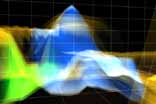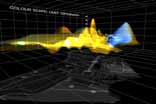|
|
||||
| LAB[au]. Lightscape(s), displacement maps, a light plan for the Heysel plateau, Bruxelles | ||||
| [in italiano] | Light_scape(s), is an urban enlightening study, commissioned by the Belgian electricity producer and distributor Electrabel-Sibelgaz, for the Heizel plateau, the world exhibition area of 1935 and 1958 in Brussels (B). The lightplan is both a research for operative tools to conceive light in the scale of the city as well as the conception of light as a dynamic vector within the urban matrix. |
[30sep2000] | ||
   The screenshots of the application illustrate the display of light in form of a blue grid according to the variation of intensity, and colour throughout the different time cycles. This spatio-temporal visualization of light allows a global as well as a specific view of the intervention. |
The project articulates the intervention of light by exploiting the potentialities of light being a structural and spatial as well as a temporal and interactive device. Each of the different characteristics of light corresponds to a conceptual step of the project where -the structural device, called 'light topography' creates diversified 'lightscapes' throughout the specific and varying enlightening of point, line, surface and interface -the temporal device, called light_urbanism, extend light to a variable and evolving support corresponding to fix, variable and reactive enlightening devices. The conjunction of the specific light parameters (intensity, color…) to the relative ones of urbanism (topography, flows, infrastructure…) and the temporal one's ( programs, activities…) determinates the different enlightening configurations, lightscape(s). The dynamic conception of light therefore describes the urban experience according to the collective use of space (events) or as an interactive support according to the relation and perception of the individual. |
|||
 Reactive: the phosphorescent blocks of the "C car park" absorb light information, emitted by natural as well as artificial sources, to become themselves luminous. The crossing of one single car though this place for example produces a luminous trace temporarily visible on these blocks. The period of time between the occurring of an event and its disappearing is considered as an "hypertrace", an individual and interactive shaping of space.  The variable light interventions are established on the linkage of activities and light. During non activity periods, the stadium for example is enlightened to its minimum level by a red "led ribbon" displaying sports news. This device is completed by colour coded enlightening of the lower face of the rows in medium activity periods and by the four light masts in maximum activity periods. This device so composes a colour code, according to the RGB code, where the synthesis of all colours (white) correspond to the maximum activity periods. |
||||
| Founded '95 LAB[au], laboratory for architecture and urbanism, links theoretic research LAB[a+u] to concrete works of conception and realisations LA.BAU. LAB[au] elaborates a 'hyperdesign' investigating the implications of new technologies of communication and computation in production, conception, as well as in spatial and social processes in order to conceive an architecture able to integrate the new conditions of transmissible realities. The 0.1lab label stands for a work on the World Wide Web as a vector for the creation of a new working environment, a collaborative agency, as well as the base for a new matrix of social interaction and collective space. | The lack of tools to identify and verify the projected enlightening hypotheses at the urban scale has lead to the exploration of computer software, allowing dynamic and programmed (computer generated) simulations. Throughout the development of a specific design software, the project explore light, immaterial and variable material, within a global vision of light evolving in space and time. The data processed light plan, which throughout the spatial and temporal programming of light creates temporal light-scapes. Thus, the use and conceptualization of functions, called 'displacement maps' have out ranged the classic use of the computer tool, and lead to its active integration in the process of creation itself and to the ability to work with light on an urban scale. In its approach, the project is a research for another form of public lighting outgrowing the simple question of a practical and technical device of security but becomes much more like a polysemic medium broadened to the urban scale, the cultural dimension of the public realm. |
|||
 Interactive card index combining the 4 main navigation systems according to the general concepts of the light-plan study. The web site http://www.lab-au.com/lightsc is designed as an interactive card displaying 4 navigators, each offering a specific thematic approach of the project, in one single screen. At any moment of the lecture the visitor can activate one of the navigators directly centring on the corresponding subject. The displayed information directly depends on the specific state of the reading. The user so can permanently complete the card in order to obtain related images, texts, graphics. which successively lead to a global understanding of the interconnection between the processual design method 'displacement maps', the structural organisation of light within the urban 'light-topography' and the dynamic conception of light 'light_urbanism'. The combination of the four navigation systems with consultation and visualisation in one single device therefore exploits the electronic medium potentials to create simultaneous and dynamic reading forms, developing an intertextual understanding of both the project as well as the implication of new conception tools within the design process. LAB[au], laboratory for architecture and urbanism M.Abendroth, J.Decock, N.Mestaoui + K.Pecheur et P.De Smedt-Jans |
||||
LAB[au] IN A BIT |
||||
laboratorio
|
||||